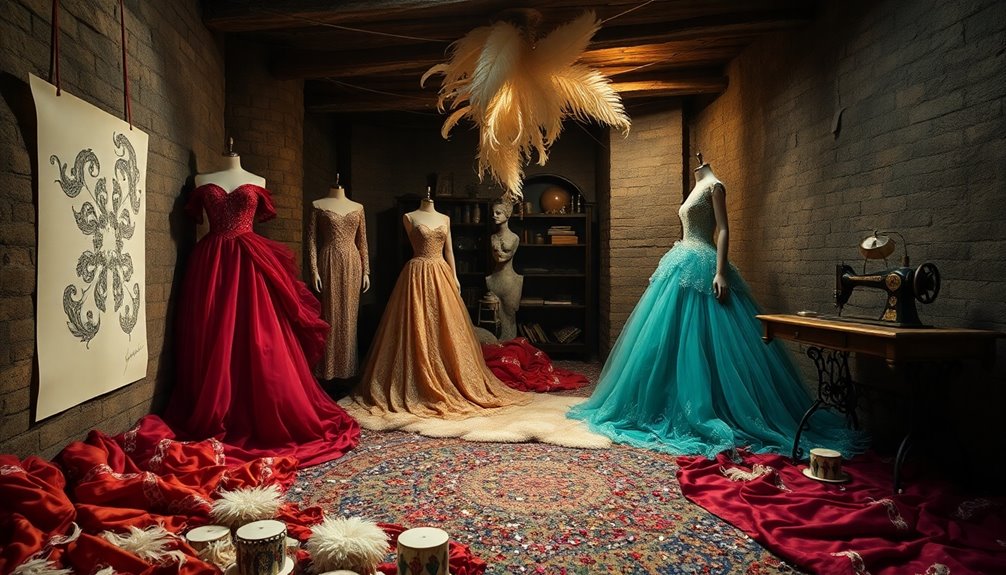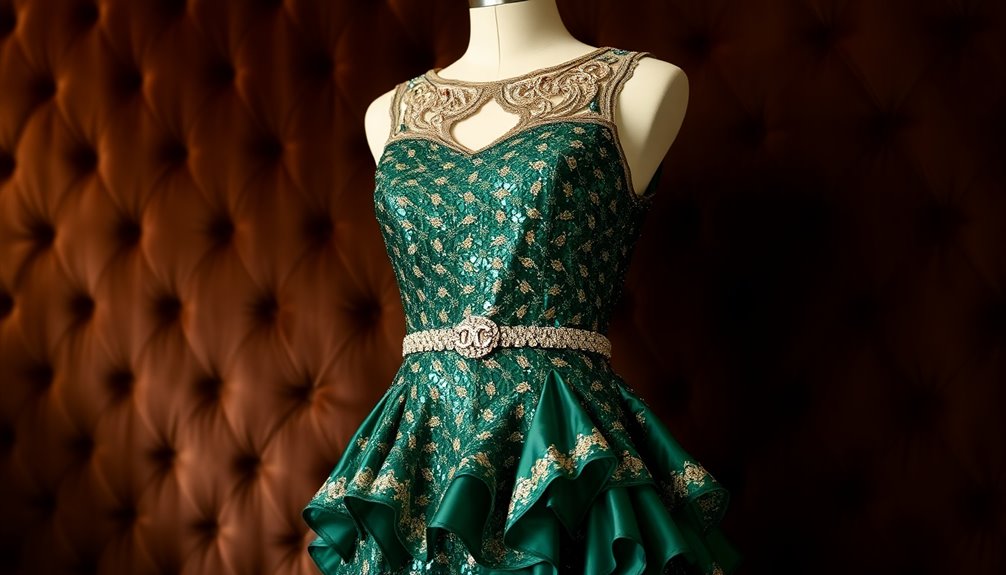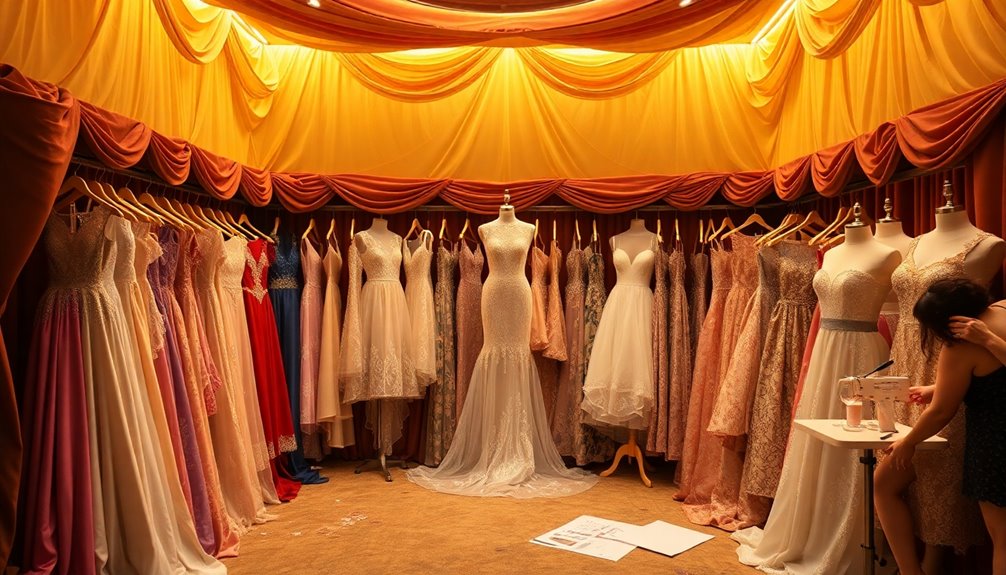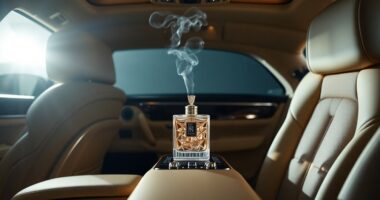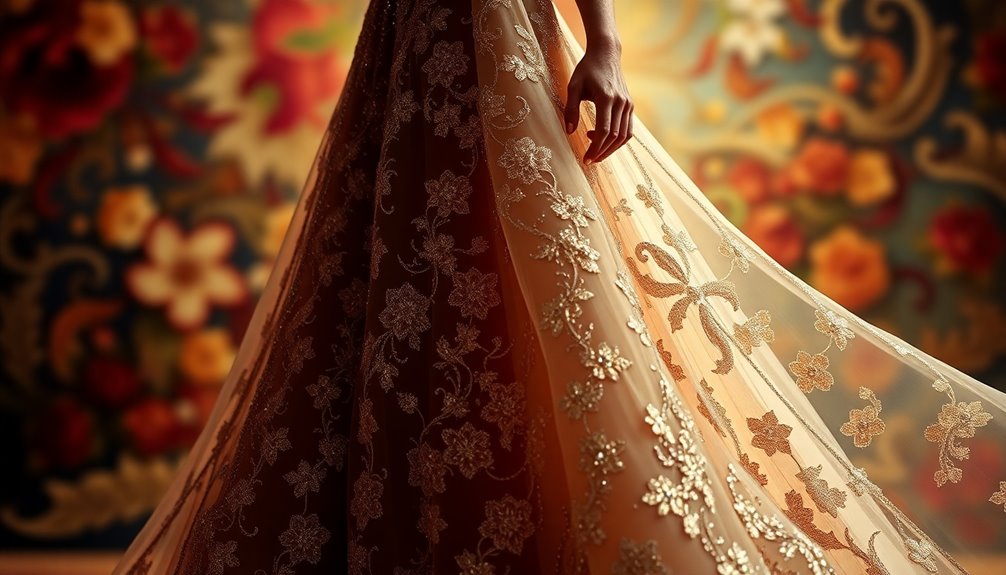The secret underground world of haute couture is a blend of artistry and exclusivity that you rarely see. You'll discover that iconic designers like Chanel and Dior craft masterpieces, each piece requiring up to 150 hours of labor. With only about 4,000 haute couture clients globally, the experience is tailored just for them, featuring personalized fittings and culinary encounters with creative directors. However, this luxury comes at a price, with costs ranging from $10,000 to over $20,000 per garment. The hidden narratives of representation and cultural influence weave through this glamorous facade, inviting you to uncover more intriguing details.
Key Takeaways
- Haute couture's exclusivity often hides a network of underground designers who challenge traditional norms and create alternative fashion narratives.
- The monumental effort involved in high dressmaking, such as labor-intensive techniques and meticulous craftsmanship, is often overlooked by the mainstream.
- Financial barriers, with production costs ranging from $10,000 to $20,000 per piece, create an elite circle difficult for many to penetrate.
- Diversity issues persist, with limited representation of marginalized designers and models in haute couture, fueling underground movements for inclusivity.
- Social media has become a platform for exposing the underground fashion scene, allowing new talent to gain visibility and disrupt established norms.
The Allure of Haute Couture
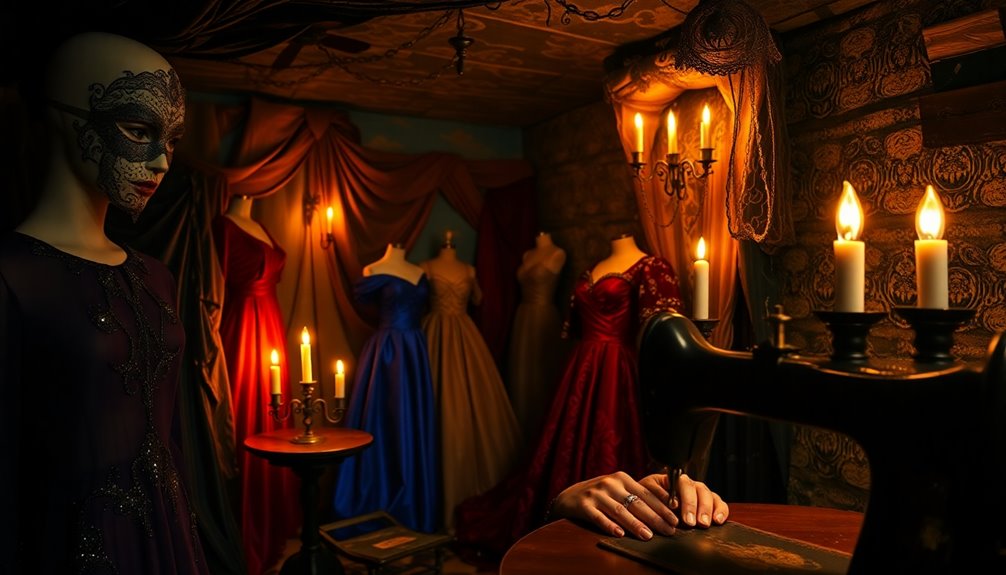
The allure of haute couture lies in its exceptional craftsmanship and exclusive nature. When you step into the world of haute couture, you experience a rich history that traces back to 1858 with Charles Frederick Worth. His establishment of the first genuine Couture House in Paris set the stage for a fashion revolution.
By 1945, the term gained legal significance, reinforcing its prestigious standing in French culture and solidifying Paris as a global fashion capital. This status is maintained by the Fédération de la Haute Couture et de la Mode, which regulates the industry and ensures the authenticity of haute couture designers.
Haute couture garments aren't just clothes; they're masterpieces. Crafted from high-quality, rare fabrics, each piece is made with meticulous attention to detail by skilled artisans, often requiring multiple fittings. The labor-intensive process can take up to 150 hours for a single piece, showcasing the dedication of experienced seamstresses and technical experts.
Moreover, the theatrical fashion shows during Paris Couture Week elevate the experience, where designers present original designs that inspire awe. The combination of art, history, and craftsmanship gives haute couture its unique charm.
You'll find that it's more than fashion; it's a cultural powerhouse with significant influence on modern styles, from fast fashion to ready-to-wear designers.
Inside the Exclusive Circle
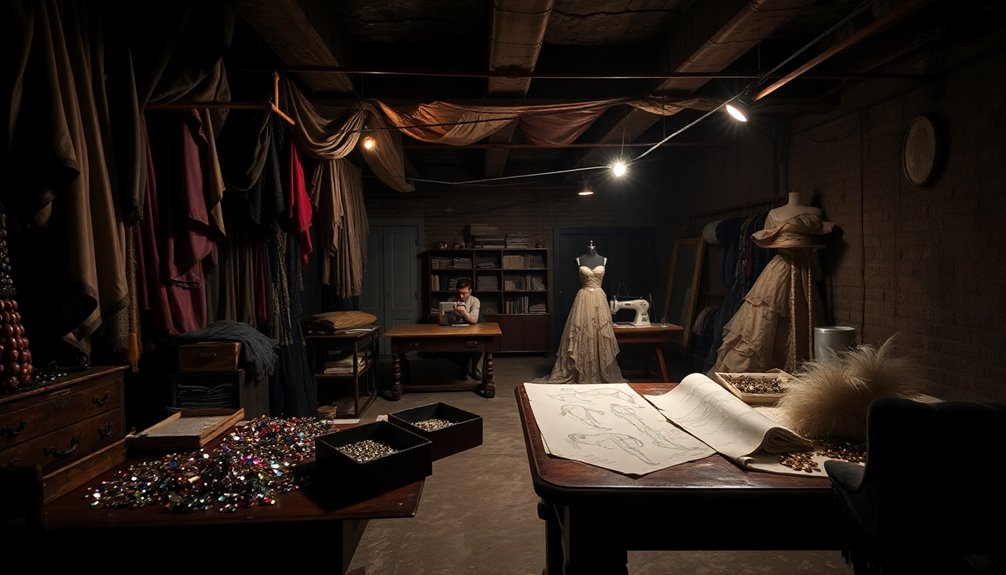
Stepping into the world of haute couture means entering an exclusive circle where only a select few can truly belong. Official members include iconic French houses like Chanel, Dior, and Givenchy, while correspondent members feature prestigious foreign fashion houses such as Armani, Valentino, and Elie Saab. New talent often makes their mark as guest members, showcasing innovative designs in jewelry and accessories.
To maintain their status, haute couture houses must meet strict criteria. They need to present at least 50 original designs each fashion season, ensuring every piece is bespoke and handmade, often requiring multiple fittings. A minimum of 35 bespoke, handmade pieces must be presented during fashion week to uphold their haute couture status.
The ateliers must be located in Paris, employing at least 20 full-time technical staff to uphold the artistry involved.
The clientele of haute couture is equally exclusive, with many clients preferring anonymity. High-profile individuals, including Queen Rania of Jordan, form a small circle of clients willing to invest in these exquisite creations.
Confidentiality reigns supreme, as couture houses safeguard their client lists, drawing a veil over who truly wears these works of art. With only about 4,000 haute couture customers worldwide, the allure and mystique of this exclusive circle remain unchallenged.
Designers Behind the Glamour
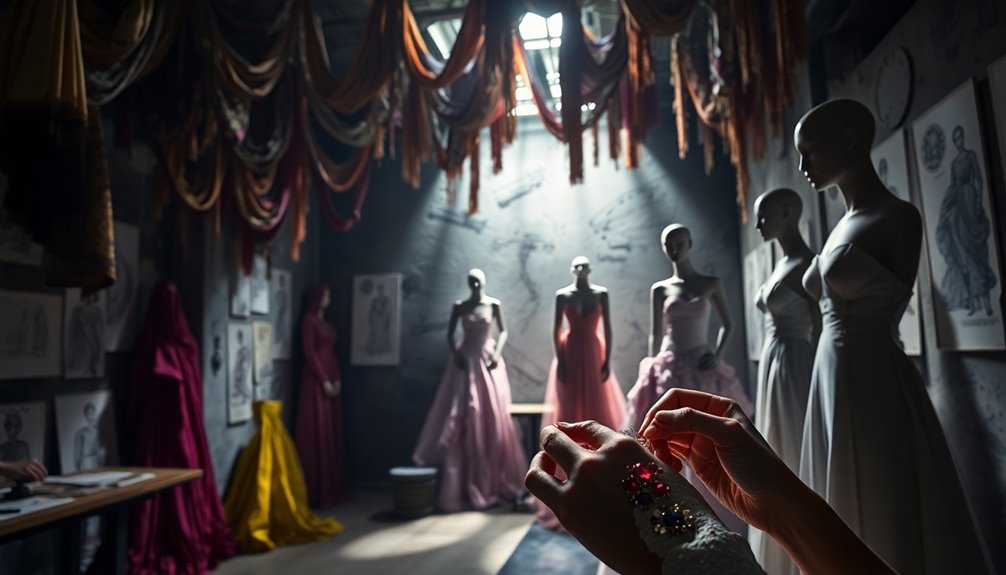
Behind the glamour of haute couture lies a diverse array of visionary designers who've shaped the fashion landscape. You can't help but admire the legendary founders like Coco Chanel, who revolutionized women's fashion, and Christian Dior, whose "New Look" defined post-war elegance.
Cristóbal Balenciaga, known as the "couturier of couturiers," crafted architectural shapes that pushed boundaries. Then there's Hubert de Givenchy, epitomizing Parisian elegance, and Valentino Garavani, synonymous with timeless Italian glamour. The world of haute couture is also characterized by exceptional craftsmanship that emphasizes artistry and quality, with many designers drawing inspiration from celebrity transformations that highlight resilience and change.
As the industry evolved, revolutionary designers emerged. Yves Saint Laurent popularized le smoking, while Jean Paul Gaultier dared to challenge conventions with avant-garde designs.
Alexander McQueen transformed fashion shows into captivating performance art, and Paco Rabanne brought innovation with his metallic creations.
In today's world, modern icons continue to influence haute couture. Giorgio Armani masters understated luxury, while Tom Ford injects sex appeal into brands like Gucci.
You'll also find the likes of Marc Jacobs rejuvenating Louis Vuitton and Issey Miyake pioneering innovative textiles. Contemporary influencers like Maria Grazia Chiuri and Olivier Rousteing ensure the legacy of haute couture remains vibrant and relevant.
Each designer leaves a unique mark, solidifying their place in fashion history.
The Clientele Experience
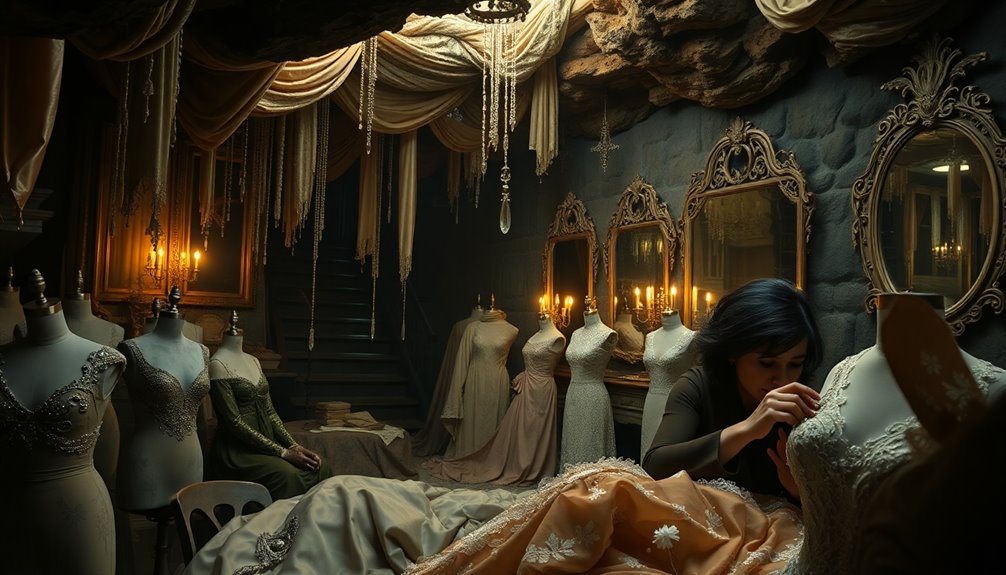
Haute couture isn't just about breathtaking designs; it's an exclusive experience tailored for a discerning clientele. When you step into a haute couture house, you enter a world where entire floors are dedicated to your needs, ensuring no queues or restrictions. Each appointment is meticulously prepared, allowing you to focus on finding that perfect piece.
Exceptional sewists take your measurements, adjusting or crafting designs specifically for your silhouette. Some fashion houses even fly seamstresses to you for in-person fittings, enhancing the personal touch. Additionally, the use of blockchain technology ensures that your identity remains secure throughout the process, reinforcing the exclusivity of your experience.
Your experience doesn't stop at fittings; you might find yourself dining with the creative director, deepening your connection to the brand. As the clientele becomes increasingly global, including wealthy individuals from emerging markets, the environment remains competitive and urgent.
You may text sales reps immediately after a runway show, racing against other clients to secure coveted pieces. The customization process emphasizes craftsmanship, with each piece tailored to your exact specifications.
This attention to detail and the exclusivity of the experience make haute couture not just about fashion, but a lifestyle that celebrates your individuality and status in the world of luxury.
Cost of Luxury Fashion
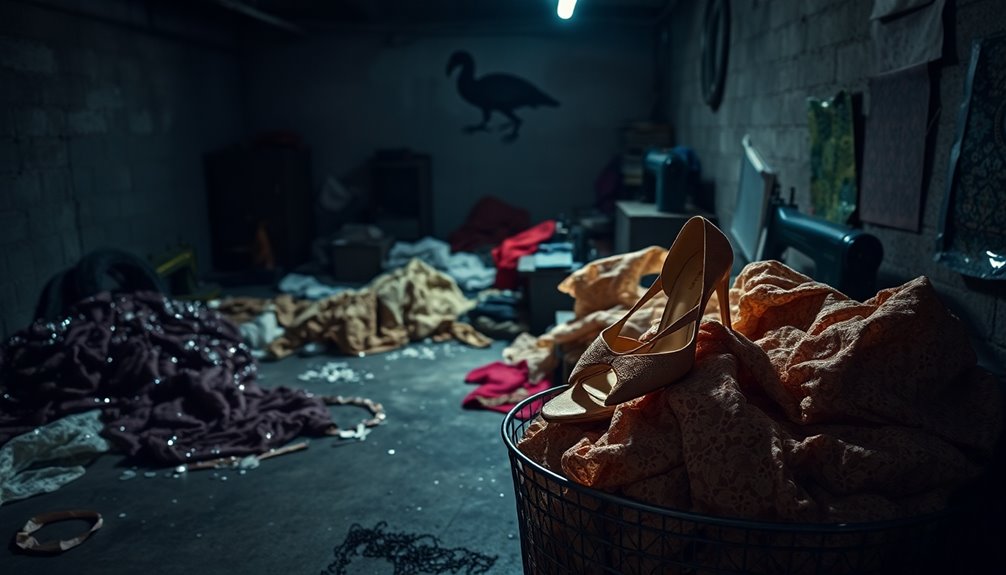
When you're diving into the world of luxury fashion, the costs can be staggering yet fascinating. By 2024, the luxury fashion market is projected to reach a whopping USD $115.9 billion, with luxury leather goods alone expected at USD $79.36 billion. These figures show that despite economic challenges, consumer spending on luxury items remains strong. Additionally, the global luxury goods market is projected to reach USD 418.89 billion by 2028(418.89 billion by 2028), indicating a robust future for the industry.
The production costs involved in crafting high-end fashion are significant. Depending on styles, materials, and colors, manufacturing can range from $10,000 to $20,000 per piece. High-quality materials can add thousands to sourcing costs, while sampling a single style can set you back around $75.
Even with these expenses, larger production orders can help lower costs per unit through economies of scale.
Starting a luxury brand isn't cheap either; initial costs can range from $500 to $50,000. You need to consider manufacturing, marketing, and overhead expenses.
It's clear that investing in quality production and materials is crucial, not just for brand image but also for justifying the high price tags. In this intricate world, understanding these costs is essential for anyone looking to navigate luxury fashion successfully.
The Art of High Dressmaking

Luxury fashion isn't just about the price tag; it's also an intricate process that transforms creative visions into tangible masterpieces.
You begin by gathering inspiration from diverse sources—art, history, or your personal experiences. Creating mood boards helps you capture your theme with images, colors, and textures, while sketches provide a preliminary look at the silhouettes you envision. Selecting fabric swatches allows you to determine the perfect materials for your designs.
As you move into design and development, collaboration with pattern makers becomes essential. They help translate your sketches into templates. You produce prototypes to test the fit, construction, and overall appearance, conducting multiple fittings with models to ensure everything aligns perfectly. Adjustments refine your designs before final production. This phase ensures that precision and attention to detail are paramount in creating high-quality garments.
In production, you utilize high-quality materials and precise techniques, employing skilled artisans who maintain couture standards. Rigorous quality control inspections ensure excellence, while traditional craftsmanship—like hand-embroidery—adds a luxurious touch.
Finally, you present your collection through runway shows or immersive experiences, adapting designs for individual clients, showcasing the luxury and creativity that haute couture embodies.
Representation in Media
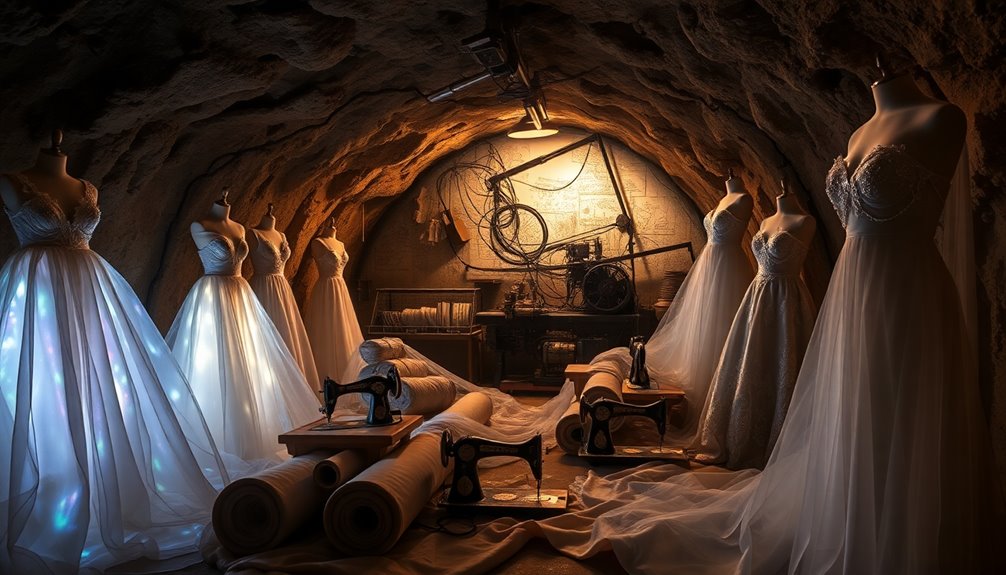
In the world of fashion, representation in media plays a crucial role in shaping perceptions of haute couture. The industry's exclusionary nature is often highlighted through runway shows and media portrayals, predominantly featuring white models and designers. You might notice that only one creative director of the top ten high fashion houses is a person of color. This lack of diversity reinforces the notion that haute couture is inaccessible to most, as it caters to a wealthy, predominantly white clientele.
While social media has opened doors for some diverse voices, the gap between performative representation and genuine creative control remains vast. You may see diverse models on the runway, but often they lack true influence in the design process. Fashion serves as a medium for media coverage can celebrate or criticize haute couture, yet it rarely confronts the systemic issues that hinder authentic representation.
Despite these challenges, advocacy for diversity could drive significant change. By promoting inclusivity and collaboration, the media can help shift the narrative, encouraging a more sustainable and ethical fashion landscape.
Ultimately, the way haute couture is presented in media can either perpetuate elitism or pave the way for a more inclusive future.
Impact on Popular Culture
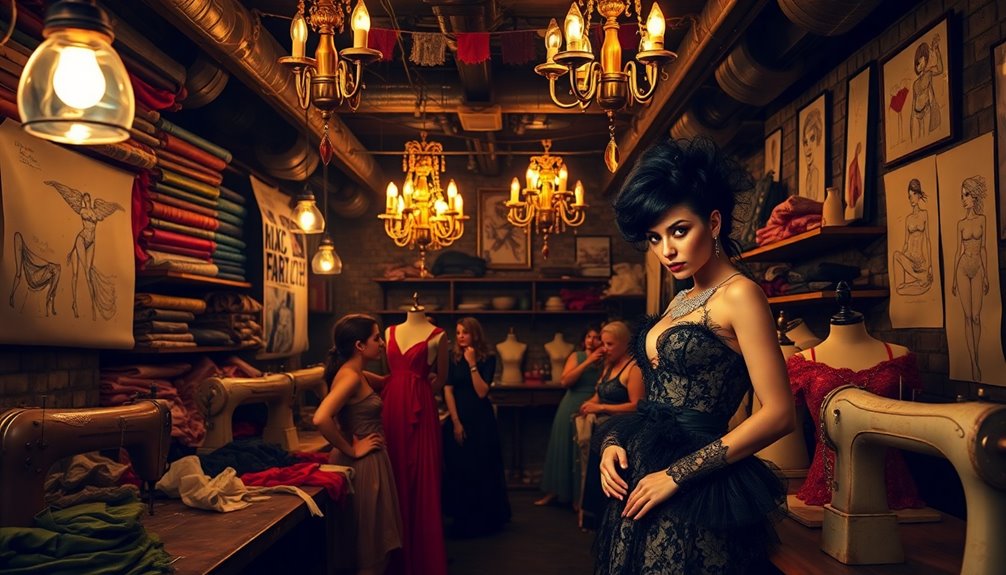
Haute couture significantly shapes popular culture, often setting the stage for fashion trends embraced by the masses. When you see celebrities like Madonna or Kim Kardashian donning haute couture on red carpets, it sparks immediate interest and influences mainstream fashion. This phenomenon, sometimes dubbed the "Kate Middleton effect," shows how quickly a piece can sell out once a celebrity wears it.
Social media amplifies this impact; every post and story reaches a global audience, making haute couture more accessible to younger trendsetters.
Beyond celebrity influence, haute couture integrates deeply into music and film. Iconic pieces designed by talents like Jean-Paul Gaultier redefine visual aesthetics, blurring lines between fashion and entertainment. The high standards set by haute couture also elevate expectations in other fashion sectors, ensuring that craftsmanship remains a priority across the industry.
Moreover, haute couture serves as a cultural symbol, representing luxury and exclusivity. Its intricate designs inspire artists, photographers, and filmmakers, pushing creativity across multiple domains.
Frequently Asked Questions
What Are the Main Challenges Faced by Haute Couture Designers?
Haute couture designers face several challenges.
You've got high material costs and a labor-intensive production process that raises expenses.
Staying relevant means adapting to ever-changing fashion trends and consumer preferences, which can be tricky.
Finding and training skilled artisans is crucial for maintaining quality, but it's time-consuming.
Plus, strict regulations and the need for originality in collections add pressure.
Balancing tradition with innovation is essential to thrive in this exclusive fashion realm.
How Do Haute Couture Collections Influence Ready-To-Wear Fashion Trends?
Haute couture collections significantly influence ready-to-wear fashion trends by introducing innovative designs and daring silhouettes.
As you explore these collections, you'll notice how exaggerated shapes, intricate details, and bold colors often filter down to mainstream fashion.
Designers draw inspiration from haute couture, adapting unique elements into their seasonal lines.
This cycle of creativity ensures that haute couture sets the stage for upcoming trends, shaping styles that eventually resonate with everyday consumers.
What Role Does Technology Play in Haute Couture Design Today?
Technology plays a crucial role in haute couture design today.
You'll find CAD and digital pattern making streamline the process, allowing for precise, customizable templates. Body scanning creates perfect fits, minimizing waste.
Advanced tools like 3D printing and AI enhance creativity and efficiency, enabling intricate designs that push boundaries.
With virtual prototyping, you can save time and resources while fostering global collaboration, making the design process not just faster but also more sustainable.
Are There Any Sustainable Practices in Haute Couture Production?
Yes, there are sustainable practices in haute couture production.
You'll notice designers focusing on custom-made garments, which significantly cut down on waste compared to mass production.
They often use organic fabrics like cotton and wool, promote recycling through repurposed materials, and prioritize lower production volumes.
How Do Cultural Influences Shape Haute Couture Styles and Trends?
Cultural influences shape haute couture styles and trends by infusing designs with historical significance and social context.
You'll notice how movements, like the French court's elegance or the impact of global events, inspire collections.
Designers often draw from artistic references, fabrics, and techniques that reflect their heritage.
As you explore haute couture, appreciate how these elements create a rich tapestry of fashion that evolves while staying rooted in cultural identity and expression.
Conclusion
You’ve just scratched the surface of the secret underground world of haute couture. This exclusive realm, filled with artistry and extravagance, is defined by the designers’ passion and the elite clientele’s desire for uniqueness. As you dive deeper, you’ll discover how this luxurious fashion shapes popular culture and media representation. The allure of haute couture isn’t just about garments; it’s a lifestyle, a statement, and a testament to creativity that continues to captivate and inspire. Victoria’s Secret journey explained the influence of haute couture on mainstream fashion and the impact of these extravagant designs on everyday clothing. The intricate craftsmanship and attention to detail showcased in haute couture pieces set the bar for fashion innovation and creativity. As you delve further into this hidden world, you’ll come to understand how Victoria’s Secret journey explained the evolution of haute couture and its enduring legacy in the fashion industry.
